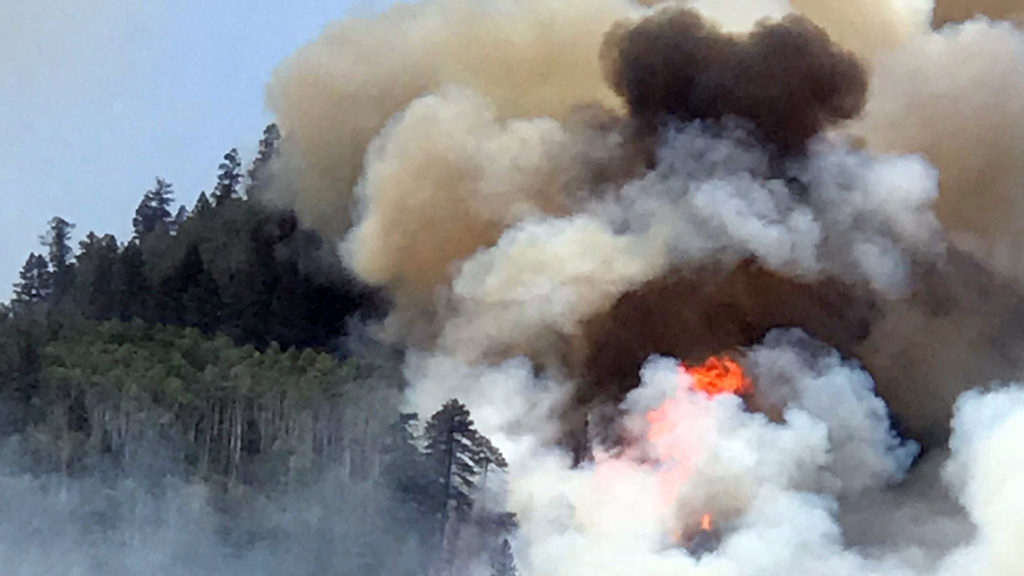
A federal judge has recommended that the Durango & Silverton Narrow Gauge Railroad could be liable not just for material damages directly caused by a massive wildfire that was allegedly sparked by the train, but also for the costs of fighting that fire.
The difference could be significant: The U.S. government is seeking to recover more than $25 million it spent fighting the 416 Fire, which burned in June and July 2018 and was one of the largest wildfires in state history.
Magistrate Judge N. Reid Neureiter’s recommendation, filed on Dec. 27, is not a final decision on the matter. The judge overseeing the federal case could reject it, though they specifically asked for the magistrate’s recommendation to inform his decision.
An attorney for the railroad declined to comment on the news.
The 416 Fire burned 55,000 acres, mostly in the San Juan National Forest near Durango, and disrupted business in the busy summer tourist season. Local residents and businesses have filed a separate lawsuit in state court, also seeking damages related to the fire.
Both the state suit (filed by locals) and the federal suit (filed by the federal government) seek compensation beyond what actually burned up in the fire. They argue that a 19th-century Colorado law that deals with railroads’ liability when it comes to fire damage also applies to related costs, like resources to extinguish the fire and property damage caused by subsequent rain and mudslides that washed through the burn scar.
If the suits are successful, those claimants won’t have to prove the railroad was negligent. That would be a significant win for people trying to get the railroad to pay for damages, said attorney Thomas Henderson, who represents the Durango-area businesses and individuals suing the railroad.
There is a chance the federal judge's recommendation will have some impact on the state case, too. In October 2019, the judge in the state case said that the railroad’s liability should be limited to “those damages caused by actual burning damage or destruction by fire,” unless the railroad is found to be negligent, which would be a harder case for the local residents to make.
Henderson agrees with the federal judge’s recommendation that the railroad should be responsible for more than just the property damage caused directly by the fire. He said it’s possible he will ask the state judge to reconsider her determination based on the federal ruling in favor of a broad interpretation of the railroad’s liability.
In his reasoning, Magistrate Judge Neureiter wrote:
“I conclude that fire suppression costs are damages that may be recovered under the Railroad Statute because they are directly related to, or inextricably intertwined with, and indeed an integral element of damages to property by fires.”

Jason Dunn, the U.S. Attorney for Colorado, is representing the federal government in its attempt to recover the money spent fighting the fire.
“We are pleased with the Judge’s recommendation and look forward to moving the case forward," Dunn said through a spokesman.
In July, the U.S. government announced fire investigators found the railroad did, in fact, cause the 416 Fire. But Jack Llewellyn, who heads the Durango Chamber of Commerce, disagrees. While it's not the chamber's official position, he thinks that it may be too simplistic to blame the full scope of the fire on a spark from the railroad.
Llewellyn noted that the region recently received millions of dollars in aid, funded in part by the U.S. Forest Service, for wildfire mitigation. He said that suggests the Forest Service failed to manage the forest well enough to prevent a massive wildfire like the 416 Fire.
The train is a significant cultural touchstone and economic driver for the area. The railroad generates $250 million annually in the local economy, Llewellyn said.
“And that's from obviously the riders coming to town, but then they're staying in the hotels visiting Mesa Verde, the kind of ripple effect when people ride the train, they experience a lot of other iconic things that the Four Corners offers,” Llewellyn said.
And the town of Silverton, with a population of 650, might not exist if it weren’t for the train delivering riders for lunch and shopping during the summer and fall, he added.
Because of the railroad’s significance, the issue of whether the train should be held financially liable has split the community. While several local businesses and residents have elected to sue, Llewellyn said there are many more that have not joined the lawsuit against the railroad.
“When you look at the number of businesses that aren't involved in the lawsuit, it to me shows the huge support that the train has,” Llewellyn said.
Attorneys expect the railroad company to file an objection to the magistrate judge’s recommendation. The final decision on the extent of the railroad’s potential liability won’t be made until at least mid-January, after the deadline to file such an objection has passed.
CPR's Kelley Griffin contributed to this story.








